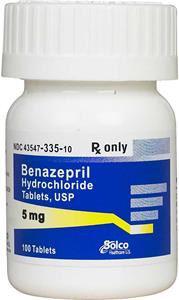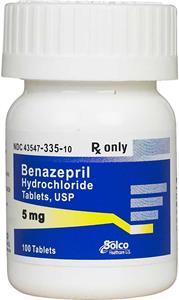Providing Quality & Trust || Clinic Website
Benazepril Tablet Solco Brand
Solco
$0.29 - $29.00
$0.29 Each
Detailed Description
Benazepril
(ben-a-za-pril)
- Description: Angiotensin Converting Enzyme (ACE) Inhibitor
- Other Names forthis Medication: Lotensin®
- Common Dosage Forms: Veterinary: 2.5 mg, 5 mg, & 20 mg tablets (20 mg not available in the USA).
Benazepril may be given either with food or on an empty stomach. If your animal vomits or acts sick after receiving the drug on an empty stomach, try giving the next dose with food or a small treat. If vomiting continues, contact your veterinarian. Usually well tolerated, but vomiting and diarrhea can occur.
If your animal experiences a rash, fever, or lethargy, contact your veterinarian immediately. Very important to give benazepril as prescribed.
Do not stop or reduce dosage without veterinarian’s guidance. Your animal will likely need to have blood pressure and lab tests performed while receiving benazepril.
Uses/Indications:
Benazepril may be useful as a vasodilator in the treatment of heart failure and as an antihypertensive agent, particularly in dogs. Reasonable evidence exists that ACE inhibitors increase survival (as compared with placebo) in dogs with dilated cardiomyopathy and mitral valve disease, although imobendane monotherapy appears to be superior to benazepril alone. Benazepril may be of benefit in treating the clinical signs associated with valvular heart disease and left-to-right shunts. Amlodipine was superior to benazepril in lowering left atrial pressure in dogs with experimentally induced mitral valve regurgitation.
Use of ACE inhibitors in dogs with ACVIM Class B2 heart disease (myxomatous mitral valve disease, mitral regurgitation, and cardiac remodeling resulting in cardiomegaly but without clinical signs) remains somewhat controversial. In dogs with Stage C heart disease (myxomatous mitral valve disease and mitral regurgitation resulting in clinical signs of heart failure) and Stage D heart disease (myxomatous mitral valve disease and mitral regurgitation resulting in clinical signs of heart failure refractory to standard treatment for Stage C heart failure from mitral valve disease), ACVIM recommendations are to use an ACE inhibitor as part of multimodal therapy.
ACE inhibitors may also be of benefit in the adjunctive treatment of chronic kidney disease (CKD) and for treatment of protein-losing glomerulonephropathies. Studies demonstrate that benazepril reduces UPC ratios over the progression of canine and feline CKD. According to the Fortekor® label (Australia), benazepril increases survival in cats with chronic kidney disease associated with a urine protein:creatinine (UP:C) ratio greater than or equal to 0.8.
Benazepril is cleared via both renal and hepatic routes in contrast to enalapril (primarily renal), potentially allowing it to be more safely administered in patients with decreased renal function. Benazepril may also be an effective treatment for idiopathic renal hemorrhage in dogs.
Outside the United States (eg, United Kingdom, Australia), benazepril is indicated for reducing protein loss associated with chronic kidney disease in dogs and cats and for the treatment of heart failure in dogs.
In one comparative feline study, telmisartan and benazepril each reduced UP:C as compared with baseline, but only the reduction by telmisartan reached statistical significance.
How is this medication useful?
Benazepril is used to treat heartfailure, high blood pressure, and some forms of kidney disease in dogs and cats.
The FDA has approved this drug for use in humans, but it is not officially approved for use in animals in the USA.
The FDA allows veterinarians to prescribe products containing this drug in different species or for other conditions in certain situations.
You and your veterinarian can discuss why this drug is the most appropriate choice.
How should this medication be given?
For this medication to work, give it exactly as your veterinarian prescribed. It’s a good idea to always check the prescription label to be sure you are giving the drug correctly. May be given on an empty stomach or with food.
- If your animal vomits or acts sick after receiving the drug on an empty stomach, try giving the next dose with food or a small treat. If vomiting continues, contact your veterinarian. If you have difficulty getting your animal to take the medicine, contact your veterinarian or pharmacist for tips to help dosing and reducing the stress of medication time.
This medication can be given for various lengths of time. Be sure you understand how long your veterinarian wants you to continue giving this medication. Prescription refills may be necessary before the therapy will be complete. Before stopping this medication, talk to your veterinarian, as there may be important reasons to continue its use.
If you have any other questions about this medication, contact your veterinarian or pharmacist.
What are the side effects ofthis medication?
Common, but not serious side effects include:
- Vomiting, diarrhea, or lack of appetite. If vomiting or lack of appetite occurs, giving this drug with food may help.
You don’t have to be overly concerned if you see any of these signs unless they are severe, worsen, or continue to be a problem. Contact your veterinarian if this happens.
Side effects that may be serious or indicate a serious problem:
- Rash, lethargy, or fever could indicate an allergy to the medication.
If you see any of these signs, contact your veterinarian immediately.
Precautions/Warnings:
Benazepril is contraindicated in patients that have demonstrated hypersensitivity to ACE inhibitors.
ACE inhibitors should be used with caution in patients with hyponatremia or sodium depletion, hypotension, hypovolemia, coronary or cerebrovascular insufficiency, aortic or pulmonary stenosis, pre-existing hematologic abnormalities, or a collagen vascular disease (eg, SLE). Patients with severe congestive heart failure should be monitored very closely on initiation of therapy.
Because ACE inhibitors may decrease GFR and worsen azotemia, they are generally avoided in critically ill acute kidney injury patients.
The efficacy and safety of Fortekor® Flavor Tabs has not been established in dogs or cats below 2.5 kg body weight.
Benazepril can potentially be confused with Benadryl® on written prescriptions and written or verbal orders. Use tallman letters to distinguish (ie, benAZEPril, benADRYl).

Powered by nopCommerce
This site is running in live payment mode. Real payments will be processed.

